You’ll find ten excellent fuel options for your backyard fire pit, each offering unique benefits. Seasoned hardwood provides authentic crackling and aroma, while propane and natural gas deliver convenient push-button control. Wood pellets and manufactured firelogs burn cleaner than traditional wood, and bio-ethanol offers eco-friendly flexibility. Charcoal reaches high temperatures for extended burns, electric elements produce zero emissions, and hybrid systems combine multiple fuel types. Each option varies in cost, maintenance, heat output, and environmental impact, so you’ll discover which best matches your specific needs and preferences.
Seasoned Hardwood: The Traditional Choice for Authentic Fire Experience
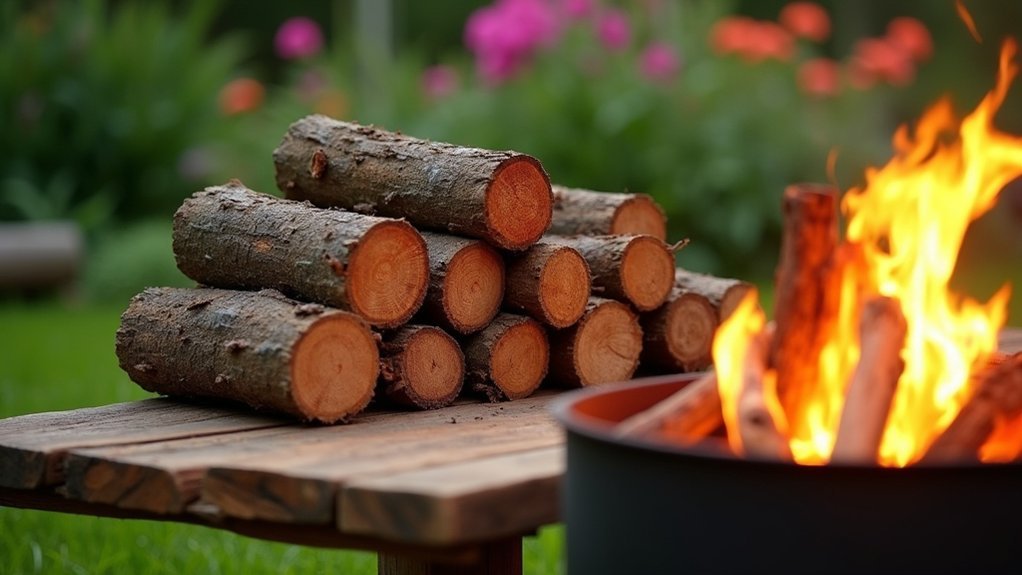
When you’re seeking the most authentic fire pit experience, seasoned hardwood stands as the gold standard that countless generations have relied upon.
Oak, hickory, and maple deliver superior burn time and heat output compared to softer woods, thanks to their high density. You’ll need wood that’s been properly seasoned for 6-12 months, achieving 20% moisture content or less for efficient combustion and minimal smoke.
Your wood-burning fire pit creates that classic crackling sound and pleasant aroma that defines a traditional fire experience.
While seasoned hardwood is economical and widely available, you’ll face ongoing maintenance requirements including ash cleanup and proper storage to prevent pests and rot.
Propane Gas: Convenient Push-Button Control for Modern Backyards
For those who prioritize convenience over tradition, propane fire pits deliver instant gratification with their push-button ignition systems.
You’ll appreciate the adjustable heat controls that let you customize flame height for any occasion, from intimate gatherings to larger parties.
This clean-burning fuel eliminates the hassles of traditional wood fires. You won’t deal with smoke-free operation means no stinging eyes or clothes that reek afterward, plus there’s zero ash cleanup required.
Propane’s portability makes it ideal portable fire pit fuel for camping trips or rearranging your outdoor space. Standard 20-lb or 40-lb tanks transport easily wherever you need them.
Operating costs typically range from $1.80 to $3.20 per hour, giving you predictable expenses based on actual usage rather than constantly purchasing firewood.
Natural Gas: Unlimited Flames Through Direct Pipeline Connection
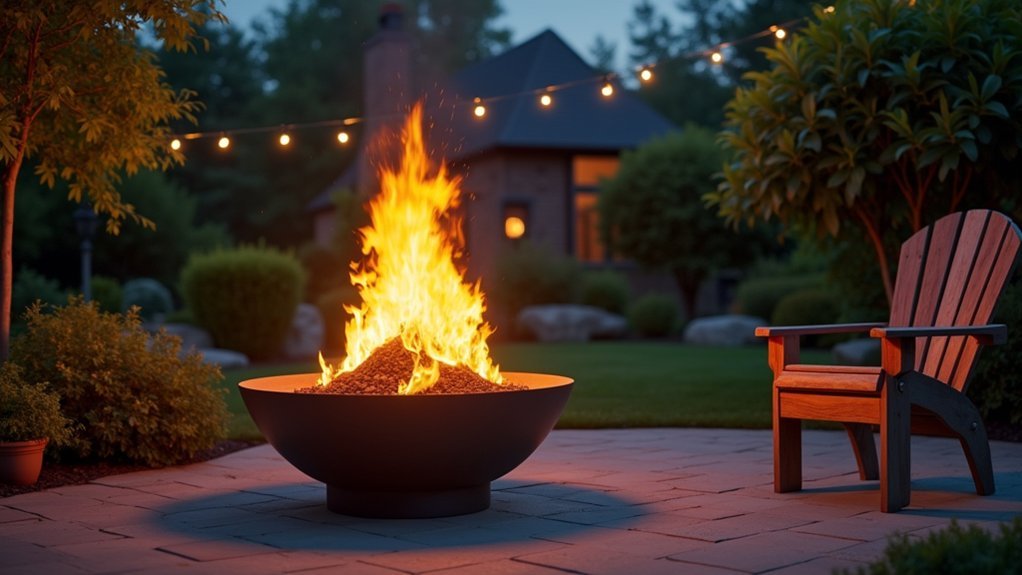
If you’re tired of running out of fuel mid-gathering, natural gas fire pits eliminate that frustration by connecting directly to your home’s existing gas pipeline.
You’ll enjoy an unlimited supply of fuel without worrying about tank refills or running empty during events.
Installing the natural gas line costs around $2,300 and requires professional installation, including permits and inspections.
However, this investment pays off through consistent high heat output that’s perfect for frequent use and large gatherings.
Natural gas fire pits operate cleanly and efficiently, producing zero smoke or ash, which means you’ll spend less time on cleanup and maintenance.
Plus, natural gas offers lower operational costs than propane, making it an economical choice for regular fire pit users.
Wood Pellets: Compressed Efficiency With Clean Burning Properties
Wood pellets transform sawdust waste into a powerhouse fuel that delivers exceptional efficiency for your backyard fire pit. This compressed sawdust creates a denser fuel option that generates higher energy output per unit weight than traditional logs.
You’ll appreciate the clean burning properties that produce considerably less smoke, ash, and emissions, making wood pellets an environmentally friendly choice for outdoor fire pits.
You’ll need specialized pellet-burning equipment to maximize this efficient fuel’s potential, ensuring consistent and even heat distribution. The compact size makes storage and transportation effortless compared to bulky logs.
When properly burned, wood pellets achieve heat output comparable to seasoned hardwood, delivering the same warmth and ambiance you expect from your outdoor gatherings.
Manufactured Firelogs: Long-Lasting Alternative to Split Wood
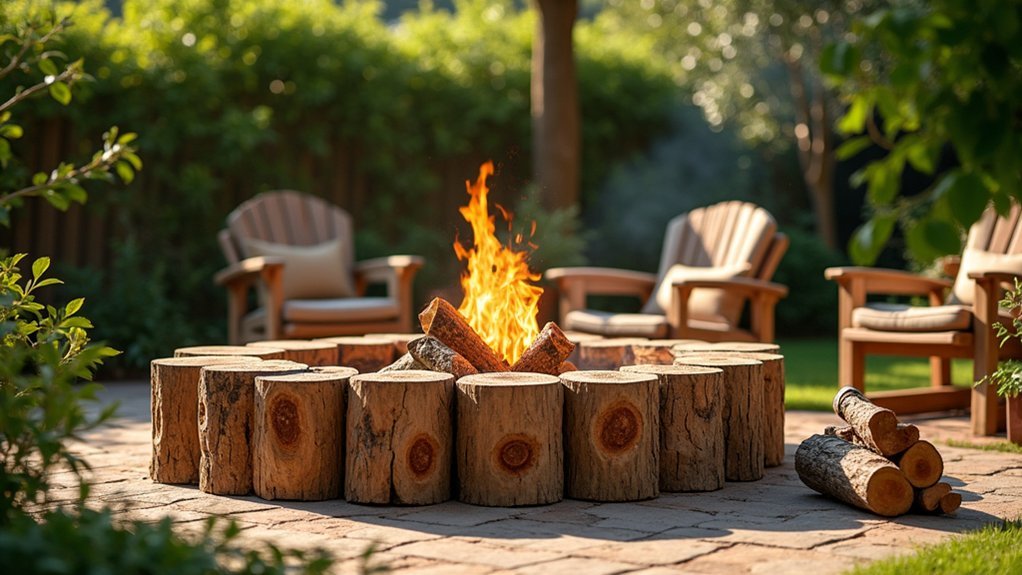
You’ll find manufactured firelogs offer a compelling alternative to traditional split wood through their unique composition of compressed sawdust and wax.
These engineered logs burn consistently for 3-4 hours, greatly outlasting most natural wood options while requiring minimal maintenance.
When you’re weighing the upfront cost against their extended burn time and reduced ash cleanup, firelogs present an attractive value proposition for regular fire pit users.
Composition and Manufacturing Process
Compressed under intense pressure and heat, manufactured firelogs transform recycled materials like sawdust, wood chips, and agricultural byproducts into dense, uniform fuel sources that outperform traditional split wood.
This sustainable alternative creates a cleaner option for your backyard fire pit while supporting environmental responsibility.
The manufacturing process bonds these waste materials through compression, eliminating binders or chemicals. You’ll get consistent burn characteristics because each log maintains identical density and composition.
This precision engineering guarantees easy ignition and steady heat output.
When you choose manufactured firelogs, you’re contributing to improved air quality. During combustion, they produce noticeably fewer pollutants and particulate matter than regular firewood.
The dense composition also means less smoke and ash, keeping your outdoor space cleaner while delivering longer-lasting fires.
Burn Time Performance
Beyond these quality advantages, manufactured firelogs deliver exceptional burn time performance that makes them a superior choice for extended outdoor gatherings.
You’ll get 3-4 hours of consistent warmth per log compared to traditional split wood’s 1-2 hour burn time. This extended performance means you’ll spend less time feeding your fire and more time enjoying it.
Manufactured firelogs provide steady heat output throughout their burn cycle, maintaining comparable BTU levels to seasoned wood without the temperature fluctuations.
You’re also choosing an environmentally friendly option that produces less smoke and ash. Since they’re made from compressed sawdust and recycled materials, they’re a sustainable option that eliminates the need for chopping and stacking while delivering superior performance.
Cost Versus Benefits
How much should you expect to invest in manufactured firelogs compared to traditional split wood?
While firelogs costs range from $5 to $10 per log versus cheaper upfront wood logs, you’ll discover significant benefits that justify the investment.
These fuel types deliver superior efficiency with 2-4 hour burn times, eliminating the labor costs of chopping and stacking traditional wood.
You’ll save money long-term through their clean burn technology, which produces less ash and reduces chimney maintenance expenses.
Firelogs offer immediate convenience without preparation time, making them cost-effective when you factor in labor savings.
Their consistent performance and reduced cleanup requirements provide excellent value, especially for occasional users who prioritize efficiency over bulk purchasing traditional wood.
Gel Fuel: Portable and Smokeless for Urban Fire Pits

When you’re dealing with strict urban air quality regulations or limited outdoor space, gel fuel offers a clean-burning solution that won’t irritate neighbors or violate city ordinances. This portable option burns smokelessly and odorlessly, making it perfect for urban fire pits where traditional wood fires aren’t permitted.
| Feature | Details |
|---|---|
| Burn Time | 2-6 hours per canister |
| Heat Output | Consistent heat output for small gatherings |
| Setup | No electricity or plumbing required |
| Cost Factor | Ongoing costs accumulate with frequent use |
| Design | Modern designs enhance patio aesthetics |
You’ll appreciate gel fuel’s convenience for occasional use, though the ongoing costs of replacement canisters make it less economical than wood or gas for regular entertaining. It’s ideal for compact spaces requiring stylish, functional heating solutions.
Bio-Ethanol: Eco-Friendly Indoor-Outdoor Flexibility
You’ll find bio-ethanol stands out as one of the cleanest-burning fuel options available, producing only heat, water vapor, and minimal CO2 without any smoke, soot, or ash.
This fuel’s unique ventilation-free design lets you place your fire pit virtually anywhere indoors or outdoors without worrying about flues or specialized installation requirements.
When you choose bio-ethanol, you’re making an environmentally conscious decision that reduces greenhouse gas emissions by 59%-86% compared to fossil fuels while maintaining impressive fuel efficiency.
Clean Burning Benefits
Since bio-ethanol derives from renewable plant sources like corn and sugarcane, it’s become one of the most environmentally responsible fuel options for your backyard fire pit. This clean burning fuel dramatically reduces greenhouse gas emissions by 59%-86% compared to traditional fossil fuels, making it truly eco-friendly.
| Clean Burning Feature | Bio-Ethanol Benefit |
|---|---|
| Emissions | Minimal CO2 output only |
| Smoke Production | Zero harmful smoke |
| Indoor Air Quality | Safe for enclosed spaces |
| Fuel Efficiency | Up to 98% efficiency rating |
| Ventilation Needs | No ventilation required |
You’ll appreciate how bio-ethanol produces only heat, water vapor, and minimal CO2 when burning. This exceptional fuel efficiency means less waste and better indoor air quality, allowing you to enjoy your fire pit anywhere without environmental concerns.
Indoor-Outdoor Versatility Options
Bio-ethanol’s clean-burning properties reveal remarkable placement flexibility that traditional fire pits simply can’t match.
You’ll discover that bio-ethanol fire pits offer true indoor-outdoor versatility options, functioning safely in any well-ventilated space without requiring venting systems or complex installations.
These units excel in user-friendly operation—simply pour fuel directly into the burner on any sturdy surface.
You won’t need gas lines or electrical outlets, giving you complete freedom in placement and design choices.
The impressive fuel efficiency of up to 98% maximizes your investment while supporting eco-friendliness through considerably reduced emissions.
Whether you’re enhancing your living room ambiance or creating backyard entertainment spaces, bio-ethanol delivers consistent aesthetic appeal across diverse environments, making it the most versatile fuel option available.
Environmental Impact Advantages
When considering environmental responsibility, bio-ethanol stands out as the most sustainable fuel choice for fire pits, delivering greenhouse gas reductions of 59%-86% compared to fossil fuels according to EPA data.
This eco-friendly fuel offers significant environmental impact advantages:
- Clean combustion – Bio-ethanol burns cleanly without producing smoke, soot, or ash, eliminating harmful particulates that damage both outdoor environments and indoor air quality.
- Renewable sourcing – Derived from plant materials, this sustainable fuel reduces dependence on finite fossil fuel resources.
- Exceptional efficiency – With up to 98% fuel efficiency, bio-ethanol minimizes waste during combustion.
- Zero ventilation requirements – You can use bio-ethanol fire pits indoors without compromising air quality, making them versatile for any setting.
The growing market reflects increasing consumer awareness of greenhouse gas emissions and environmental responsibility.
Charcoal: High Heat Output for Extended Burn Times
Although charcoal takes longer to ignite than gas alternatives, it delivers exceptional performance that makes the wait worthwhile. You’ll experience high heat output reaching 800°F or more, perfect for achieving restaurant-quality searing and grilling results.
The extended burn times are impressive—lump charcoal sustains heat for up to 5 hours while briquettes maintain consistent temperatures for 4 to 6 hours.
Despite the longer startup time of 15 to 30 minutes, charcoal remains affordable at $10 to $30 per bag.
Despite requiring patience during startup, charcoal delivers exceptional value with bags costing just $10 to $30.
Beyond cooking performance, you’ll appreciate the warm glow that transforms your backyard into an inviting space for outdoor gatherings. This natural ambiance creates a cozy atmosphere that gas simply can’t replicate, making charcoal ideal for memorable evenings.
Electric Fire Elements: Zero Emissions for Restricted Areas
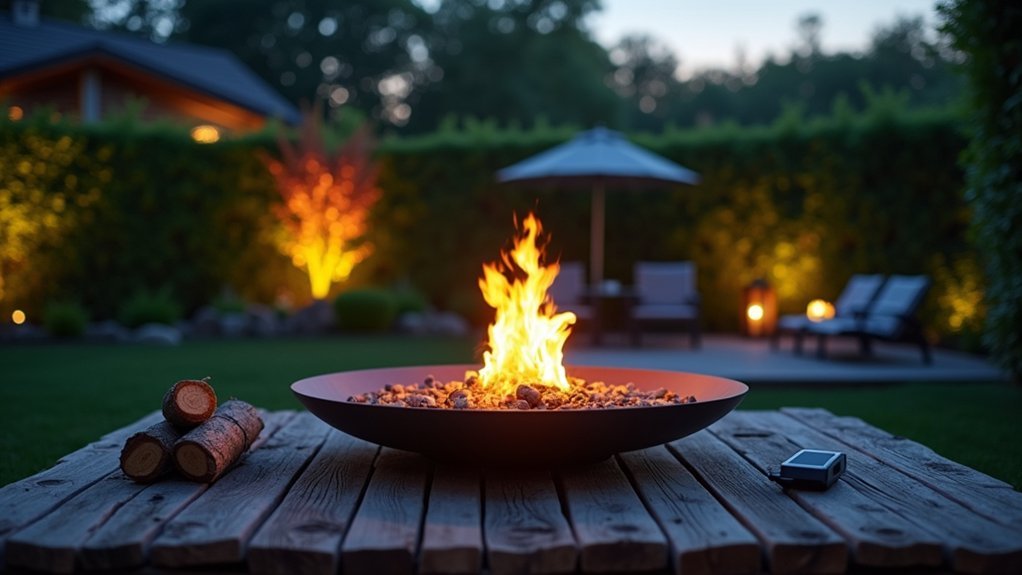
Electric fire elements offer the perfect solution if you’re dealing with HOA restrictions, apartment balcony regulations, or urban fire bans that prohibit traditional open flames.
These electric fire pits produce zero emissions through LED technology and heating elements, making them compliant with strict regulations while providing safe indoor and outdoor use.
Their plug-and-play design delivers exceptional versatility:
- No fuel costs – eliminate ongoing propane or wood expenses
- Adjustable heat settings – customize warmth to your preferences
- Easy setup – no fuel storage or refills required
- Space flexibility – perfect for apartments and limited outdoor spaces
However, electric units generate less heat than wood or gas alternatives.
You’ll likely need multiple units for larger outdoor spaces to achieve adequate warmth throughout your gathering area.
Hybrid Fuel Systems: Combining Multiple Options for Versatility
Hybrid fuel systems maximize your fire pit’s potential by combining multiple fuel sources into one versatile unit.
Get the best of both worlds with dual-fuel flexibility that adapts to any outdoor occasion or gathering need.
You’ll enjoy the convenience of propane or natural gas with push-button ignition and adjustable flames, while still having the option to burn wood for that authentic campfire experience.
This versatility lets you adapt to different occasions—use gas for quick, clean burns during casual evenings, then switch to wood for special gatherings that demand rustic ambiance.
Your outdoor fire pit becomes more economical too, as you can rely on natural gas for regular use while reserving wood for memorable events.
Hybrid systems eliminate individual fuel limitations, giving you quick ignition when needed and longer-lasting heat for extended outdoor entertaining sessions.
Frequently Asked Questions
What Is the Best Fuel for a Portable Fire Pit?
Propane’s your best choice for portable fire pits. You’ll get easy setup, adjustable flame control, and high portability that’s perfect for camping and outdoor gatherings. It’s convenient and doesn’t require special equipment.
How Long Will a 20 Lb Propane Tank Run a Fire Pit?
You’ll get 8-20 hours from a 20 lb propane tank, depending on your fire pit’s BTU rating. Higher BTU models burn faster, while lower settings extend runtime. Wind and temperature also affect how long it’ll last.
What Type of Fire Pit Gives off the Most Heat?
Seasoned wood fire pits give off the most heat, producing 80,000 to 100,000 BTUs per hour. You’ll get maximum warmth from hardwoods like oak or maple that’ve been properly dried and seasoned.
Is Propane or Natural Gas Better for Fire Pits?
Natural gas is better if you want convenience and lower operating costs, while propane’s better if you prioritize portability and easier installation without professional help required.

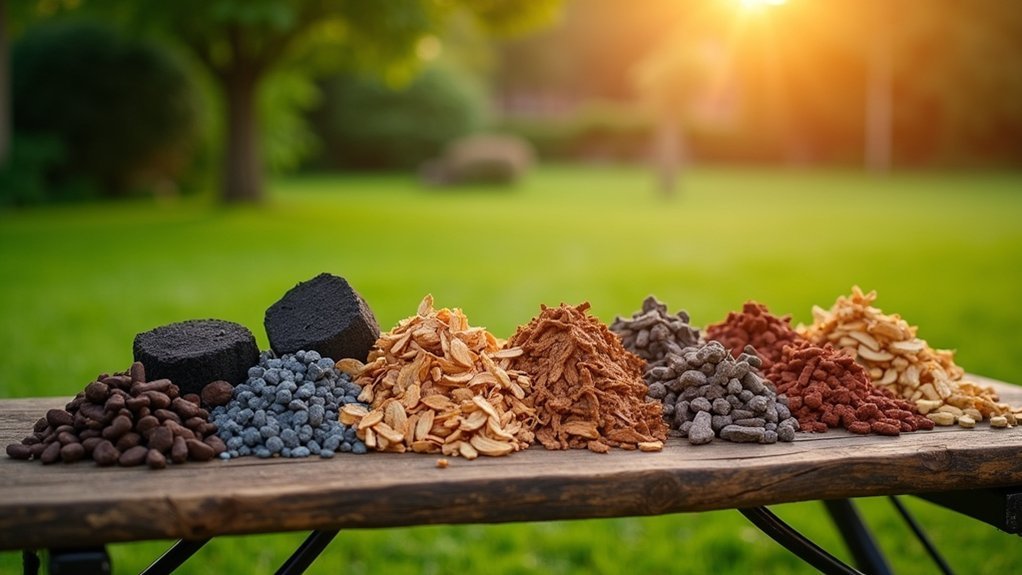



Leave a Reply